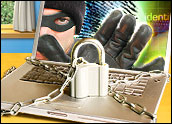
Losing a laptop may be less painful now than it used to be because the cost of replacing the physical device has trickled downward recently. You can now pick up a decent workhorse for three or four hundred dollars at a big-box retailer. Big deal if you lose it.
What hasn’t become less valuable, though, is the data held within. In fact, the data has become more valuable with the prevalence of identity theft and our copious use of the machines to store every aspect of our multimedia-driven and socially networked lives.
However, the gut-wrenching realization that your laptop has possibly been converted into a methamphetamine-induced haze for a local derelict, and is now winging its way to some unknown destination on the wrong side of town, can be alleviated with some simple precautions.
Deterrent Measures
Stow the laptop on the road by placing it in an in-room safe. The safes are usually large enough, although they don’t look it from the outside.
If there isn’t a safe in your room, place the laptop in your luggage, which should be fitted with a simple lock. You can pick the locks up at airport boutiques. Unlock the luggage and remove the laptop when checking out.
Universal Security Slot
Identify whether your laptop features a Universal Security Slot. This is a thin keyhole-like slit in the computer that can be used to accept a laptop-specific security cable. The slot is sometimes not labeled. If you have the slot, purchase a security cable that you can use to attach the laptop to a fixed object, like a railing or pipe. You can get them at office products stores. This is a good deterrent to use in a public place.
It’s just a deterrent, though, and it won’t thwart bolt cutters. Motion-sensing alarms that use the slot are also available from other vendors.
Cable Specifics
Affix the cable’s included hook to a table. The cables often ship with a strong, self-adhesive eye hook that’s designed for attaching to laptops that don’t have the security slot. The hook can also stick to any flat surface, like a table underside in a public place. Thread the cable and lock it.
When you’re finished, say goodbye to the eye hook — it will be almost impossible to remove.
Rendering Unusable
Password-protect the computer’s operating system. In Windows XP, choose the Control Panel and select “User Accounts.” Then “Edit.” The next time you log on you will be prompted for the password.
This method of rendering the computer unusable is not iron-clad, but it may spoil your average small-time crook, or a drug addict’s enjoyment of your machine.
Software Solutions
Look for encryption software that will encrypt an entire file system, or just encrypt sensitive files. Symantec makes products that can perform either task.
The disadvantage to encrypting the whole system is that read and write file operations will be slower than on a non-encrypted system.
Hardware Solutions
Install biometrics add-ons. Various shopping websites sell USB finger-print readers for under $50.
However, locking up a laptop with biometric security is probably easiest when the hardware is built into the laptop, rather than added via USB.
Tracking Solutions
Install tracking software.
GadgetTrak makes solutions that use the laptop’s WiFi location positioning and take advantage of the laptop’s webcam by capturing images of the perpetrator — useful in court.
The Cloud
Leave the laptop on overnight and back up your files to the cloud whenever you can. If you have Internet connectivity on your laptop while traveling, install backup software that will sync your laptop with the cloud and other machines that you have at other locations.
Mozy, Carbonite and SugarSync have products worth taking a look at. Allow the backup to take place during supposedly quiet hours overnight, and you won’t notice lag.
Want to Ask a Tech Question?
Is there a piece of tech you’d like to know how to operate properly? Is there a gadget that’s got you confounded?
Please send your tech questions to me, and I’ll try to answer as many as possible in this column.
And use the Talkback feature below to add your comments!





















































